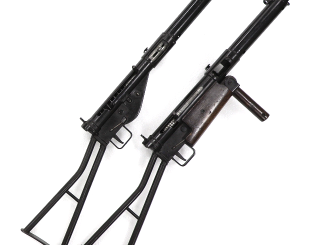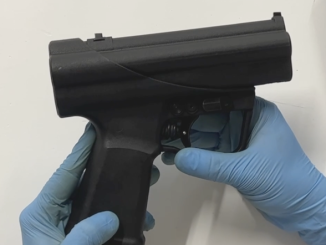One of the classic mistakes make by authors who are not “gunnies” is to have a character threateningly click off the safety catch…on a revolver (sound effects editors do it in movies and TV, too). Argh! That’s not a thing!
Except that, well, it sometimes is a thing. The Webley-Fosbery automatic revolver is the best known example, in large part due to its appearance in “The Maltese Falcon”, but there are lots of other examples of revolvers with manual safeties. Let’s have a look at a few…




I used to have a .22LR revolver with a safety. Don’t remember the brand or model. I got rid of it pretty quickly, after discovering that even with the safety on I could double-action the trigger just by pulling hard.
.22 rim-fire revolver with safety? I am aware of one such model, see photos:
https://www.pyramydair.com/blog/2014/11/the-cody-thunderbird-revolver-the-face-of-innovation/
though I don’t know if this safety can be overridden by pulling hard.
My Heritage Arms Rough Rider .22LR single action revolver has a manual hammer-block safety. I never use it but keep an empty chamber under the hammer.
I’d load 5 or 4 depending on the model and use a snap cap, to roll the first heavy trigger pull onto, then pull the hammer back for an aimed shot- practice makes perfect.
“Said hypothetical revolver would have such a facility”
If I lived in America, which I don’t.
Far too many mums getting shot in head off their 5 year olds through Glock type “Safe” automatic actions.
(O.K corall use?) pull the trigger very quick at 3-12 yrds, not exactly slow.
So no, I don’t think a revolver heavy pull is safe enough, safeties all the way with me.
Mind you ideally everyone would walk around with cowboy guns and belts on, then you just kinda squint your eyes and pull Clint Eastwood faces.
No good for me though if anyone actually pulls as I am often drunk- That’s why you have to go all Wyatt Earp clean livin etc. I’d just move to somewhere with bows and arrows, and drunk natives.
Maybe it’s just because I’m dangerous, rooow! “Kind of effeminate Tiger raw there”
Just saying, it’s a drop safety.
In the absence of fitted safeties on revolvers. I just think safeties are a good idea, in general.
On off, on off. Its not hard.
Back in early 20th century there were various idea how to implement safety in automatic pistols. Take for example Schmeisser-Pistole:
https://unblinkingeye.com/Guns/HS25/hs25.html
where it is impossible to get out magazine, while safety is off. Considering that so great diversity it is interesting that various manufacturers marked manual safety generally uniformly – S for Sicher and F for Feuer.
While much later timeline-wise Margolin .22 automatic pistol had interesting safety, as it give tactile feedback rather than visual. Which is not surprising if you take in account that its designer was blind.
This is probably what they call click bate to a U.S audience, i’d modify or delete it if I could I’m not trying to sell you swimwear or whatever.
(Bait, even)
Incidentally… There’s this new line of… No? Ok Fine.
“Far too many mums getting shot in head off their 5 year olds through Glock type “Safe” automatic actions.”
So thinking automatic pistols is safe is unsafe.
According to http://www.rossiusa.com/pdf/Rossi_Manual_Revolvers.pdf
safety is only a mechanical device, not a substitute for common sense.
You can certainly get an manual ambidextrous safety as an option, on quite alot of these types of guns.
Which if it’s going to go in a handbag, you should probably opt for one. But obviously it’s slower, to use. Slightly… But your never going to fire it in anger anyway are you, well you might. But then you might win the lottery, as oppose having your kid blow your head off. You carry your bag everyday.
Nope, I just don’t accept these arguments, the U.S Gun community are consumers and much as I like Lee Emery Rip myself, in later life his job was to sell you a product.
.38 Ruger Lcx Snap cap, job done. In a hurry? Pop it in the perps mouth and repeatedly pull the trigger.
Lcrx 2″ barrel, .38 special without the + power rounds.
IIRC some European police forces had a policy of applying a seal on the safety to discourage officers from playing with their side arms.
I recall seeing French policemen carrying Smith & Wesson K-frame revolvers that were fitted with manual safeties. The French were more worried about “flicks”
having their own weapons turned against them, by snatchers, than accidental discharges. The Webley MK 3 revolvers that were issued to colonial policemen had manual safeties for the same reason that French police guns did: officer survival. A goon fumbling with a weapon that he was unfamiliar with gave the officer a few seconds to deploy his truncheon, a savate kick, flee, etc.
Good idea in Belgium recently, car key activated guns even.
“Notice I didn’t say electronic guns, I meant a car key literally or your be hacked by say Russians (Bogeyman) etc. Who’ll force you to shoot your dog or something, for a laugh in Siberia.”
The German Reichsrevolvers (1879 and 1883 models) had the big thumb safety due to the fact that they had non-rebounding hammers with hammer-mounted firing pins.
Normally, such a single-action would be carried with the hammer down on an empty chamber, like a Colt Peacemaker with “five beans in the wheel”. But the German Army specified fully-loaded revolvers.
Therefore, the drill was to half-cock the hammer, apply the safety, load the cylinder clear around, put the loaded and safed revolver in the full-flap holster (very like the later “hard shell” Parabellum holster, with a thick and inflexible “flap”), with the flap secured, and make very sure the lanyard was properly attached to the revolver’s butt ring and the other end was firmly secured under the epaulet strap.
Other than the Fosbery, Webley revolvers often had thumb safeties. All Mk IV “commercial” 0.380″ revolvers had a place for one- that odd rectangular hole going right across the frame in the pawl behind the hammer, at the top of the grip backstrap. It was there to accommodate a crossbolt safety that locked the hammer when in the “down” position. On MK IVs without it, the grip panels were extended upward to cover the square hole.
The Webley top-break pocket revolver in .32 caliber could always be ordered with a thumb safety, right, left, or both sides. It was usually a lever type that was “Safe” when down, “Fire” when up, and was first introduced on the earlier solid-frame Webley “British Bull Dog” double action revolver. This was most likely the original of the revolver safeties Ian demonstrated. Some late MK IV series pocket .32s had a scaled-down version of the crossbolt safety at the top of the backstrap.
Incidentally, a .32 caliber Webley pocket revolver of this type, with thumb safety, belonging to Dr. Watson figured prominently in the Sherlock Holmes story “The Problem of Thor Bridge”;
https://ebooks.adelaide.edu.au/d/doyle/arthur_conan/d75ca/chapter7.html
You’ll have to read it yourself if you haven’t already. I wouldn’t dream of giving away the plot.
😉
cheers
eon
That (German) gun on the video, resembles a RIC Royal Irish .442 etc Constabulary revolver to me, don’t know if it is a copy or if they had safeties but if they did; if they weren’t drop safeties from horseback perhaps they were Paddy confusers I.e. They get it and go ha ha! Click. Eh. Then, they got a truncheon up the bum-
And said novel alluded to was born.
Still doing that in France apparently. I wouldn’t usually agree, but there’s a surely a limit to the amount of cars you can illegally torch before someone sticks a baton up your bum? I’m not an lawyer, but I’m sure Napoleon who wrote theor garlic legislation would agree.
Wurrr.
“German”
Manual safety can be found also on some other than Reichsrevolver German revolvers, for example DECKER: http://www.littlegun.info/arme%20allemande/artisan%20c%20d/a%20decker%20walter%20gb.htm
Or this revolver known in collectors parlance as Saxon 1874:
http://www.horstheld.com/0-Sachsen.html
Supposedly the idea of the Decker was to make a .25 pocket revolver that “looked like” an automatic, hence the fake ejection port on the right.
I tend to disagree. I think the designer decided to start from a clean sheet of paper and come up with a pocket revolver intended to work, no matter what, be as safe as possible, and also be streamlined enough that not only wouldn’t it catch on the pocket when you tried to draw it, you could if need be fire it from inside the pocket without jamming it. The linear “plunger” trigger and DA-only mechanism make it clear that this is a close-range defensive arm with no pretense of being anything else.
The manual safety automatically being engaged when you open the loading gate is one of those “why didn’t everybody else think of that?” things. Along with shoving it forward, rather than up, down, back or widdershins, to release it. “Forward” is a natural thumb movement; the other directions, not so much.
the safety is less an affectation than a practical necesity, because the revolver has no guard over that linear trigger. Without the safety, if the trigger gets pushed back by anything, like the side of a wallet or even a lighter, the gun will fire. The lack of a trigger guard was to ensure that nothing got in the way when it had to be fired.
The “fake ejection port” on the right is actually there for a very practical reason. The right side of the cylinder is enclosed to streamline the weapon, to eliminate snagging on the draw. but there has to be an opening there to push the cylinder out to the left, either for unloading or for cleaning. The rectangular “port” is a sensible way of doing it.
The Decker was probably the most advanced pocket revolver ever designed. Today, I suspect that a new version in .22 LR would find a decent market.
cheers
eon
Don’t forget the S&W “lemonsqueezers”. Hammerless safety revolvers, with the grip safety.
There also existed Austrian Gasser 1898 variant with grip safety, see photos:
http://www.horstheld.com/0-Gasser.htm
I am going to guess, in the absence of any manual or directions from manufacturer or salesman, that the manual safeties not on the Reichsrevolver here were to assist safe CARRY, that neither trigger nor hammer could snag on the way into holster or pocket to discharge the revolver, or while being carried, and that you took the safety off (upwards) with thumb while reaching for the gun, not after taking it out.
My understanding of the manual of arms of Walther PP, PPK, P38 etc. : carry with loaded chamber and safety off, fire first round double-action, follow up shooting single-action, when through shooting apply safety (downwards) which also drops hammer, then holster gun and while doing so push safety back upwards to fire. Thus you return to start: chambered, hammer down, safety off, ready for the next fast-draw first double-action shot. They might have been better off with a decocker only, that step next taken by Sauer, and already taken on the Radom P35.
The Webley-Fosbery safety is the one that acts in a familiar way because it is an AUTOMATIC revolver: you would carry it fully loaded, rebounding hammer safely down, cock for shot 1, gun cocks itself for subsequent shots, and if you have ammo remaining after shooting you put cocked gun on safe while you search for new targets or holster your sidearm. Handles like a single action automatic.
I had read of those cross-bolt Webley safeties and find them fascinating. But I suppose the authors will have to say “pressed the safety button” rather than “pressed the safety catch.”
The opposite peeve: crime-story authors putting safety catches on Vietnam-souvenir Tokarevs, on Glocks, on SIG-Sauers, and one day on some Kahr product.
Spider Robinson, in his novel Callahan’s Key, “put” a manual safety on a S&W M29 .44 Magnum. He also mentioned one on a .455 Webley; other than the Fosbery, the various “service” .455s were the only Webleys that never had manual safeties, as far as I know.
That said, if someone came up with a Webley-Green or etc. with one, I wouldn’t be surprised; Webley would do almost anything on “special order”. See “The Greatest of All Webley Collectors”, a satirical story with a ring of truth in it, in the Gun Digest Treasury, vol. 2, 1976.
cheers
eon
“would do almost anything on “special order””
And this is probably easiest way to retcon any revolver with safety even if that particular revolver should have not safety: either special order from factory or later custom modification.
Most of the manual safeties in double action revolvers are thought and put for the other persons than the owner.
My SPF (Singapore Police Force) marked Webley in .38 S&W has the crossbar safety mentioned above. I believe there is a similar pistol for the Hong Kong Police. Definitely an oddity. I especially like it since I lived in Singapore for many years.
Here’s a link with the normal MkIV vs the Singapore Police model with the safety. It says production of the latter ended in 1970.
http://gunlab.net/webley-mark-iv-singapore-police-pistol/
“Singapore Police Force”
Regarding Asian law enforcement, that one from PRC recently introduced new revolver for service, with manual safety:
https://modernfirearms.net/en/handguns/double-action-revolvers/china-double-action-revolvers/policejskij-revolver-eng/
Interesting. Most Chinese police one sees on the street are unarmed, I guess, as the article said, this would be a good sidearm for them. I wonder how widespread its issue today is?
By the way, Webley-Fosbery: I think this is the only case, when a revolver needs an user-operated safety. I wonder: is it possible to design an automatic/self-cocking revolver with such a decocker, which allows to not rotate the cylinder of the revolver with the next trigger pull or cocking of the hammer?
The .22 cal Heritage Rough Rider revolver, which is still in production, comes with a manual hammer block safety.
I’ve never noticed the silly sound effect with the revolver safety catch. Mistake I keep hearing is in films where they want to tell you a character has expended the ammo in their semi-auto. So instead of showing that the slide is back they have the clicking sound you would expect from an empty double action revolver.
I have a Webley .32 Mark IV (1946-1949) with a safety slide just below the hammer, in between the grips. I am, however, unable to trace its history.
Any suggestions?
I’ll be happy to send you photos.